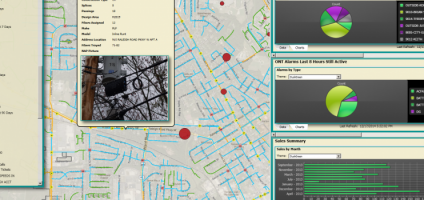

Long gone are the days when telecommunication industry leaders responded to market demands or made important business decisions inspired by gut feelings. In today’s fast-paced market, such decisions must be based on facts that are in most instances backed by large heaps of organizational data. The realization has since seen different telecom industry players delve into analytics for telecom.
Incorporation of GIS-based visual analytics in telecommunication helps the company leaders better understand their organization. Use of analytics helps the company executives and management teams to gain insights into virtually every aspect of their organization. Specifically, they can learn how consumers interact with their products and network demands and its utilization. Most importantly it helps them understand consumer demands and decision making that reduces customer churn.
Different telecom industry players have already outsourced these services from analytics companies. These industry players understand the power of information and hope to use it to expand or retain their market share as well as expand or retain their consumer base while reducing operational costs. They have particularly delved into such analytic fields as:
Telecommunication companies either collect or have access to large data resources relating to both their consumers and administrative staff like customer representatives and service vendors. However, up to now, very few companies have found any use for such data primarily because they either don’t understand its worth or didn’t have the necessary tools to convert it into useful information. Big data analytics comes in handy in such a situation as it helps to convert the raw and unstructured data into patterns that can then be used for decision making.
The raw data covers customer preferences and subscription options that can be used to create consumption patterns. From these patterns, network administrators can identify unsatisfied consumers and tailor make products aimed at reducing the subscription turnover.
In the past, customer retention strategies involved lengthy and expensive processes. However, modern-day data mining and visual analytics allow for mapping areas where churn may be occurring. It also aids in the formulation of retention options for these target customers with pinpoint accuracy. Understanding consumer retention strategies and reduced reliance on the costly traditional strategies go a long way in helping these companies increase revenues.
Predictive analytics in telecom play a significant role in helping company executives understand and predict their customer needs with utmost accuracy. In actualizing the effectiveness of this resource, telecom analytics companies have come up with tools that explore every aspect of consumer interaction with the company products and services. These give the system managers insights on the consumer preferences and needs. And based on past data analysis, a company can then structure more relevant content for the consumer, individually or collectively.
Today, the predictive insights gained from visual analytics software can also predict the success of new ideas with utmost success. By investing in analytics software, a telecom operator can also replicate this success by ensuring that they target the right customer group with the right content at the right time and through the right medium. This goes a long way in ensuring success with the service offering departments.
When deployed within the customer support departments, it plays a significant role in predicting sales. They equip the customer service representatives with relevant information about the client and how to approach them. This not only guarantees customer satisfaction but also enables the company administrators to uncover opportunities for up-sells or cross-over sales as well as predict turn-over risks.
The technology helps any telecommunications company operator, identify customers ready to buy in on their products and how to get to them. Most importantly, it helps them determine the most likely time to approach them to maximize the probability of sale as well as understand the factors influencing their purchase decision. Most telecom companies are also using the predictive feature to plan different sales strategies for their consumers and optimize their intake.
Traditionally, telecommunication companies had to employ rudimental and costly strategies to determine the effectiveness of their network utilization. This move hampered capacity planning while rendering the traffic volume forecasting almost impossible.
However, current capacity and performance management analytics make it possible for companies to not only determine the utilization of their different assets but also establish traffic forecast with a little margin for false positives.
Network administrators can use the information derived from network analytics in telecom to make more informed decisions concerning resource allocation. For instance, the insights gained here come in handy when allocating resources to networks to utilize assets to their full potential.
This helps them reduce the wastage occasioned by allocating resources to unused systems. Network analytics in telecom also aid the network administrators to have oversight over the entire business system and to improve their operations.
Telecom analytics companies don’t just help businesses keep track of their organization’s internal data. One can also infuse them with equally effective sub-analysis tools such as campaign management, and customer acquisition to help arrive at informed market decisions. These help you figure out all sales parameter that helps influence sales with different customers and how they can be manipulated to a company’s advantage.
With such tools at hand, a telecommunication industry player can set out a digital retail footprint on how a customer interacts with their products. This information can then be used to create and promote products with immense success. Plus, this doesn’t just affect the product consumers but also loops in business partners and content vendors. Different marketing analytics like market penetration and segmentation analysis may help inform the roles played by various partners in driving sales or demand.
The need to understand consumer preferences and needs, the understanding of a brand’s market share as well as the exploration of networks analytics in telecom are all aimed at driving sales. Similarly, the need to understand consumer perception of a brand or its programs as well as the type of content with which their consumers interact with most is all geared towards helping the company improve its monetization. Telecoms dealing with the subscription and paid content have to delve deeper into the analytics world and explore the subscriber-level analytics. Analytics such as ETI’s Analytics has the capability to discover buying patterns, target market to subscribers whose history shows an interest in certain products/VOD/live events.
To a large extent, this involves upselling and cross-selling or the promotional of both new and existing market products and services. It also includes using historical data to present a subscriber with tailored content within their most preferred price range to maximize sales.
Advancements made in technology haven’t just expanded the telecommunication market, they have also encouraged the entry of different brands and thus increased competition. This move implies infringement on a telecom operator’s market share as evidenced by increased customer defection and loss of interest in a brand as subscribers embrace the newcomers. There is, therefore, a need to identify and implement robust customer retention strategies.
In such a case, Big Data analytics comes in handy not only due to its effectiveness in helping a brand understand its clientele but also because of its cost efficiency. GIS data mining and analysis offer great long-term benefits. Most importantly, data analysis helps a company to gain a deeper understanding with regards to the effectiveness of its operations.
In most companies, executives are only able to arrive at final business decisions once furnished with adequate information and the telecom industry is no different. To make an informed decision with regards to customer satisfaction, network resource allocation, or even marketing strategies, telecom company executives need conclusive information. The severity of the consequences associated with wrong business moves calls for proper analysis and little room for error.
This forms the core reason telecommunication companies need to embrace the different aspects of big data analysis. Progressive companies use historical business and consumer data to empower telecom executives to arrive at optimal business decisions. The telecom analytic tools are also quite flexible and can adopt different analytical paths in coming up with tailored results based on the user’s needs. However, for telecom analytics software to deliver optimal results, one needs to first reach out to reputable telecom software developers who specialize in the telecom and broadband industries.